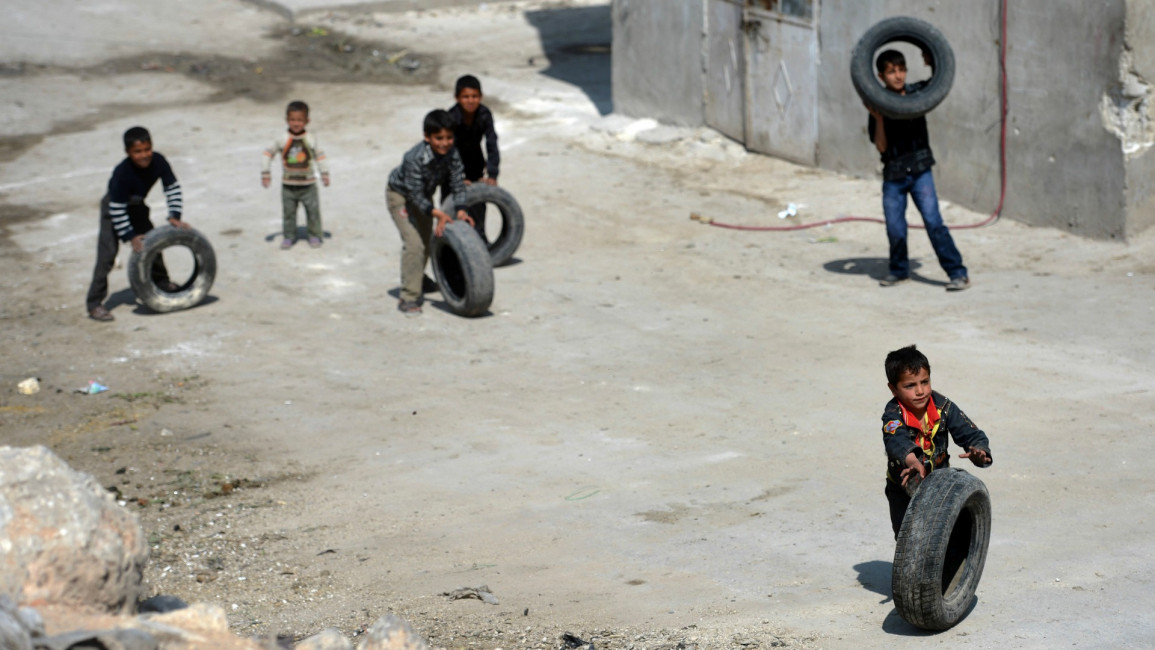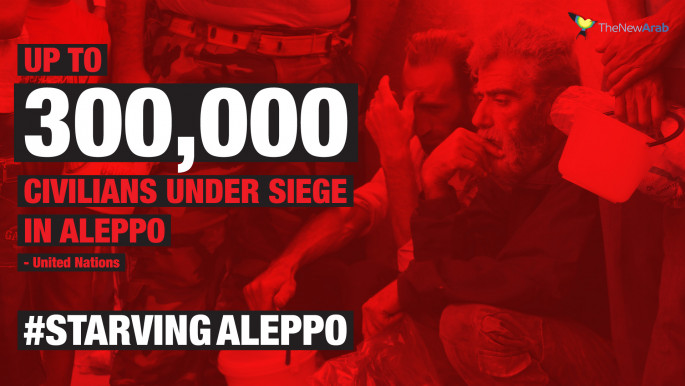
Aleppo: A lesson in resilience
Usually when one sees images of clouds of smoke engulfing Aleppo, the first question is which neighbourhood the Assad regime or Russia has hit now, and how many people have died. But three days ago something extraordinary happened. Clouds of black smoke billowed over Aleppo's skies, yet the source was not terror by the genocidal Assad alliance, but the precise opposite.
The smoke came not from burning buildings hit by Assad, but rather from the burning of hundreds, if not thousands, of tyres by ordinary residents of liberated and besieged parts of the city.
The purpose was very clear. The rebels present within Aleppo - the ones Assad and his Russian and Iranian allies have expended so much in exterminating - launched a counteroffensive to break through the encirclement of the liberated areas of the city. The residents, knowing that this was their only hope of saving the city, began to burn the tyres to provide a makeshift no-fly zone to obscure the view of Assad and Russia's air force.
The rebel counter-offensive was appropriately titled "Anger for Aleppo" and within moments of the tyre-burning being pictured and shared among news outlets and social media, it was immediately meme-ified to be used as a symbol of solidarity for Aleppo and its civilian and armed rebels.
The main symbol used by those attempting to raise awareness or simply extend support for the besieged residents and the battling rebels is a drawing of burning tyre – it's important in moments like this not to get carried away with romantic notions of war and revolution, but these symbols are extremely important.
The symbol of the burning tire simultaneously demonstrates the solemn and extraordinarily brave and, more importantly, revolutionary defiance of the people of Aleppo against the mass terror unleashed upon them by Assad and his allies. And this, because they sought to live free from this dynastic tyrant, while also demonstrating the tragic reality that these people are alone. All they have for protection against Assad's air force and, even more terrifying, the air force of the Russian Federation, is the smoke from burning tires.
 |
Russia wants to demolish the revolution bit-by-bit, person-by-person |  |
The world has forsaken them - those who posed as their friends have abandoned them, while their closest allies have never committed the kind of backing that might counter the massive support provided to the regime by Iran and Russia.
Indeed, as the pro-regime forces, now mainly comprised of foreign Shia militias and sectarian militias, led and armed to the teeth by the Iranian Revolutionary Guard Corps (IRGC), capitalised on the brute strength of Russian air strikes to encircle Free Aleppo, the US, which posed very early on as an ally of the revolution, was coming to an agreement with Russia that would widen their cooperation regarding "fighting terrorism" in Syria.
|
The Battle for Aleppo: Besiege and conquer
July 7: The Syrian regime and its allies moved in early July to capture Castello road The Syrian regime and allies, repeating tried siege tactics from places such as Homs, began a siege of rebel-held areas of Aleppo, estimated to hold 300,000 civilians. |
The deal essentially sees the US further acquiesce to Russian hegemony over Syria, including further acceptance of the Russian terms that any armed group that fights against Assad, as opposed to concentrating solely on the lesser evil of the Islamic State group (IS), ought to be considered a "terrorist".
Moreover, it formally commits the US to targeting the Nusra Front (renamed as Jabhat Fatah ash-Sham), an entity that was until recently al-Qaeda's franchise in Syria, but which, due to the necessities of war and the fact that the rebels can't fight a war on three fronts, often fights alongside rebels against Assad and IS.
The deal with Russia could then potentially see the US hit pro-democracy moderate rebel groups that have been forced to cooperate with the powerful Nusra Front, as well as the civilian areas held by the group.
As the pro-regime forces completed their encirclement, thus beginning a siege of the area with the rebels' supply routes being completely cut off, the Russians then announced that they'd open up "humanitarian corridors" to allow the civilian population of the city to leave.
While apologists lauded Russia for this, the people of Aleppo could see through the move immediately - the will of Assad and his allies has always been to isolate the armed revolution from its civilian base and to depopulate or, given the sectarian and imperialist dynamic, "ethnically cleanse" the areas of liberated Syria.
This is what lies behind these "humanitarian corridors" - any true humanitarian corridor would allow aid in to the city, as opposed to demand that safety lies in people leaving their homes almost certainly never to return. Russia wants to demolish the revolution bit-by-bit, person-by-person and, as we’ve seen with such brutal regularity, hospital-by-hospital – the point is to gut the revolution of its infrastructure and living core.
Russia knows that the mostly foreign or non-local pro-regime forces have very little chance of holding Aleppo with a hostile population who have not just experienced the terror unleashed by the very same forces that now pretend to have "humanitarian" concerns, but also a period of liberty that is antithetical to the raison d'etre of the regime.
As one resident of Aleppo, interviewed by the Guardian put it, "I will not leave, I will be the last man in the city… I can't ever imagine seeing a member of this regime again", adding that the siege was threatening "the brief feelings of independence and freedom" that came with the liberation of the city by the rebels.
But this is what much of the coverage of events in Syria is missing – the rebels are not merely hierarchical entities vying for power with an equal foe. There ought to be no sense of neutrality here.
 |
Syrians as agents of their own fate are not going to disappear |  |
As with other areas of liberated Syria, the revolution has continued under the radar of Assad's barrel bombs and all the layers of dizzying geopolitical machinations of the great powers that the media obsess over. For example, locally organised civil councils carry out the city's day-to-day governance. This might not sound very grand, but this form of organisation exists completely independently of Assad, while they often coexist organically with the armed revolutionaries.
This is what Assad and his allies are fighting to smash in Syria, but, more importantly, this is what the rebels and the people of Free Aleppo are fighting to protect. Aleppo exists as a bombed and broken beacon for the rest of Syria and beyond - a living reminder that the Syrian people can live without the presence of the tyrant and his kleptocratic, brutal system, even amid the bombs and sectarian death squads.
I must confess that when it became clear that Aleppo had been completely encircled by the pro-regime forces, and Russia was acting with a bit more than its usual imperialistic arrogance, I thought all hope was lost.
In this respect, I was completely out of sync with the people of Aleppo – they yet again reminded me through the odd symbol of a burning tyre that as long as they, the beating heart of the revolution, remain defiantly where they are, there will always be hope.
The rebels have managed to unite and, though facing hard and gruelling opposition, with the odds still stacked against them, are now only a mere 800 metres from breaking the siege. Whatever the outcome, Syrians as agents of their own fate are not going to disappear – they will burn every tyre in Aleppo if they must.
Sam Hamad is an independent Scottish-Egyptian activist and writer.
Join the conversation by tweeting us @the_newarab
Opinions expressed in this article remain those of the author and do not necessarily represent those of The New Arab, its editorial board or staff.





